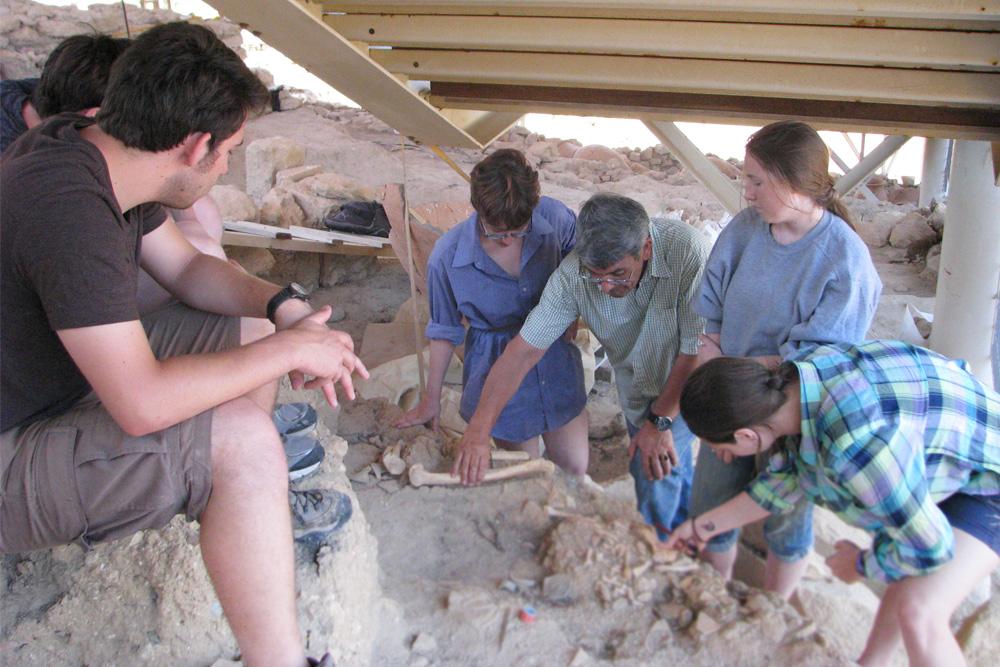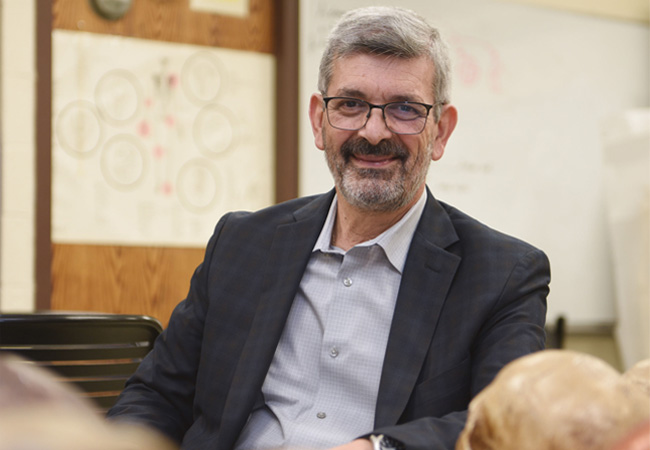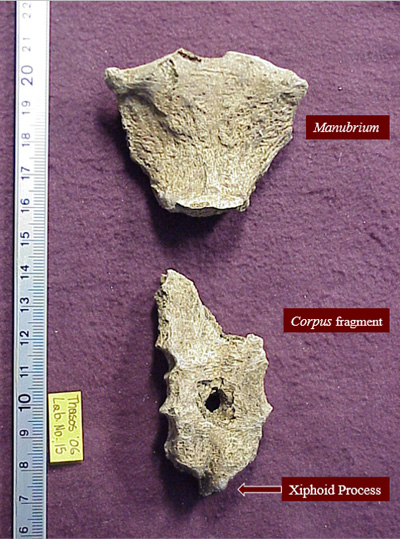Through years of detective work with faculty from several different departments at Adelphi, Anagnostis Agelarakis, PhD and his team were able to determine why the woman was buried in such an unusual manner. In the process, they challenged long-held beliefs about the role of women in ancient Greece.

Buried in a grave wedged between two funeral pyres on the Greek island of Crete, one 3,000-year-old female skeleton puzzled Anagnostis Agelarakis, PhD, archaeologist and professor of anthropology. The woman was inexplicably laid to rest on her side, with knees and hips slightly bent. On one side of the body, her joints were so worn down that the bones were almost completely smooth.
Through years of detective work with faculty from several different departments at Adelphi, Dr. Agelarakis and his team were able to determine why the woman was buried in such an unusual manner. In the process, they challenged long-held beliefs about the role of women in ancient Greece.
To unlock the secrets of the woman buried on her side, Dr. Agelarakis and his team used computer models to examine whether tasks thought to have been performed by women at the time—spinning wool, weaving fabric on a loom, planting and harvesting crops—could have caused her physical condition. When none of these possibilities panned out, they interviewed modern-day craftspeople from nearby villages to learn more about tasks that put stress on one side of the body.
Finally, the team met a master ceramicist with similar ailments who lived less than a mile from the dig site—and realized they had found a match.
Dr. Agelarakis and his colleagues worked closely with the ceramicist for seven years, learning traditional methods for throwing clay. “I told her I didn’t want her to do anything with ready-made clay,” he said. “I wanted her to start from the beginning when she fetched the clay from the quarry. We needed to see the entire process from the beginning to the end.” Dr. Agelarakis speculated that a kick wheel, much like the one used by the ceramicist, would cause the same stress-related injuries suffered by the skeleton. His hypothesis was later confirmed by a ceramicist in Adelphi’s art department.

Anagnostis Agelarakis, PhD, is renowned for his archaeological work, leading to discoveries and research that have shed light on life in ancient Aegean civilizations. His research has been widely published in scholarly journals and featured in mainstream media outlets throughout the world.
The research—made public last year at a conference at the Museum of Ancient Eleutherna—“rocked the boat” for many archaeologists working in Greece, Dr. Agelarakis noted. “This was the first female ceramicist ever discovered in Greece. Previously, the craft was thought to have been exclusively male dominated during this period. And this skeleton wasn’t just any ceramicist, but a master ceramicist who did this work day in and day out.”
The female artisan is one of many groundbreaking discoveries Dr. Agelarakis has made at Eleutherna, a centuries-old community on Crete. He unearthed two nearby funeral pyres in the cemetery of Orthi Petra with the cremated remains of more than 100 warriors, revealing much about the burial customs for those who died on the battlefield. (The Anthropology of Tomb A1K1 of Orthi Petra in Eleutherna, (University of Crete Press, 2005); “A Dignified Passage through the Gates of Hades,” (Archaeopress Archaeology, 2016).

Testing this bone fragment with a puncture led to the conclusion that the wound was caused by execution by spear.
And just feet away from those funeral pyres, he discovered an ornate eighth-century B.C. tomb containing the remains of four females ranging in age from 7 to 70, thought to be a high priestess and her three protégés, “Arcane Whispers Echoed from Burial M at Orthi Petra in Eleutherna: Contributions of Anthropological Research,” in Princesses of the Mediterranean in the Dawn of History (Museum of Cycladic Art, University of Crete, Hellenic Ministry of Cultural Affairs, 2012). That find was named one of the top archaeological discoveries of 2009 by Archaeology Magazine.
After more than four decades of experience in the field, Dr. Agelarakis still remembers his first dig. In 1975, as an undergraduate at Sweden’s Lund University, he traveled to the Greek island of Thasos, following a passion he’d first developed in high school while volunteering at archaeological sites. “On that dig, I realized for the first time that those antiquities are humanity’s record and should be open to all people throughout the world,” Dr. Agelarakis said.
On a return trip to Thasos in 2002, this time with a group of Adelphi archaeology students, Dr. Agelarakis made another discovery: the remarkably well-preserved skeleton of an older man from the Hellenistic period who had been killed by a spear to the chest. The puncture wound to the sternum told Dr. Agelarakis a great deal about the man’s death. “This wasn’t an injury on the battlefield,” he said. “The spear wasn’t thrown, it wasn’t hurled. It clearly had been done when the individual was being restrained.”
Dr. Agelarakis calls the research, which was published in Archaeopress Archaeology in April 2019, the result of a “real team effort.” Sean Bentley, PhD, associate professor of physics at Adelphi, helped analyze the skeleton’s wound, calculating the force, speed and momentum of the spear strike. Using all the data collected, David Hornung, professor of art and art history, was able to cast in bronze an exact replica of the sharp heptahedrical base edge of a thrusting spear—called a styrax—used for the execution.
[pullquote direction=”left”]“Everyone is always so impressed by the skill and sophistication our students demonstrate.”[/pullquote]
Other research conducted by Dr. Agelarakis tells the story of a bloody battle between the Byzantines and the invading Ottomans in the early 1380s. The decapitated skull of one of the defenders—found in a cemetery first uncovered by Dr. Agelarakis and his team in 1991—may have been a trophy taken by the victorious Turks. The find is a “truly spectacular time capsule of the Late Byzantine period,” he explained. His findings were published in Byzantina Symmeikta, the journal of the National Hellenic Research Foundation, in 2017; they were also reported in a January 31, 2019, article in Forbes.
But none of this work is possible without the team of archaeology students who spend their summers at dig sites around the Mediterranean, according to Dr. Agelarakis. “Everyone is always so impressed by the skill and sophistication our students demonstrate,” he said. “We are ambassadors representing not only Adelphi, but the United States.”
Over the years, Adelphi’s summer field work program has attracted significant outside funding from organizations such as the Leon Levy Foundation, which recognize the program’s value in revealing how people lived millennia ago. “We are filling in many aspects of the historical record, a story never reported by historians in great detail, and it’s all substantiated by tangible data,” Dr. Agelarakis said. “We are writing the story of these ancient people.”
For further information, please contact:
Todd Wilson
Strategic Communications Director
p – 516.237.8634
e – twilson@adelphi.edu